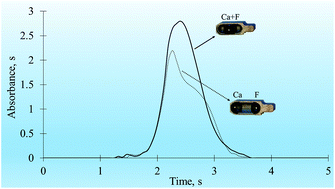当前位置:
X-MOL 学术
›
J. Anal. At. Spectrom.
›
论文详情
Our official English website, www.x-mol.net, welcomes your
feedback! (Note: you will need to create a separate account there.)
Formation of calcium monofluoride in graphite furnace molecular absorption spectrometry, part I: interference mechanisms of competitive metals Ga, Al, Ba, and Sr
Journal of Analytical Atomic Spectrometry ( IF 3.1 ) Pub Date : 2017-11-22 00:00:00 , DOI: 10.1039/c7ja00241f Nil Ozbek 1, 2, 3, 4, 5 , Suleyman Akman 1, 2, 3, 4, 5
Journal of Analytical Atomic Spectrometry ( IF 3.1 ) Pub Date : 2017-11-22 00:00:00 , DOI: 10.1039/c7ja00241f Nil Ozbek 1, 2, 3, 4, 5 , Suleyman Akman 1, 2, 3, 4, 5
Affiliation

|
Fluorine can be determined via molecular absorption of CaF generated in a graphite furnace of a high resolution continuum source atomic absorption spectrometer (HR-CS AAS). In this study, the formation mechanisms of CaF in a graphite furnace were examined. To differentiate the condensed phase and gas phase interactions during CaF formation, Ca and F were mixed as well as separately pipetted onto a platform. The main mechanism for the formation of CaF was a gas phase combination reaction between Ca and F because CaF was formed irrespective of whether Ca and F were mixed or separated. When solid tea and Ca solution or solid Ca(NO3)2 were separately introduced on the platform, a significant CaF signal was observed. Secondly, the interference mechanisms of gallium, aluminum, barium, and strontium on the formation of CaF were researched. The interferents, along with Ca and F, were mixed or separately pipetted onto the platform in various combinations. The results revealed that F and the interferent reacted both in the condensed phase and gas phase. However, a gas phase reaction between F and the interferent metal played a dominant and final role. Because F was shared between Ca and the metallic interferent, the sensitivity for CaF was changed compared to matrix-free standards depending on the interferent and its concentration. In this case, F can accurately be determined only if matrix-matching standards or better are used when the analyte addition technique is applied.
中文翻译:

石墨炉分子吸收光谱法中一氟化钙的形成,第一部分:竞争性金属Ga,Al,Ba和Sr的干扰机理
可以通过在高分辨率连续谱源原子吸收光谱仪(HR-CS AAS)的石墨炉中产生的CaF分子吸收来确定氟。在这项研究中,研究了石墨炉中CaF的形成机理。为了区分CaF形成过程中的冷凝相和气相相互作用,将Ca和F混合并分别吸取到平台上。形成CaF的主要机理是Ca和F之间的气相结合反应,因为CaF的形成与Ca和F的混合或分离无关。当固体茶和Ca溶液或固体Ca(NO 3)2时将其分别引入平台后,观察到了明显的CaF信号。其次,研究了镓,铝,钡和锶对CaF形成的干扰机理。将干扰物与Ca和F混合在一起,或以各种组合方式分别吸取到平台上。结果表明,F和干扰物在冷凝相和气相中均发生了反应。但是,F与干扰金属之间的气相反应起着主要和最终的作用。因为F在Ca和金属干扰物之间共享,所以与无基质标准品相比,CaF的灵敏度根据干扰物及其浓度而改变。在这种情况下,只有在应用分析物添加技术时使用基质匹配标准品或更佳的标准品才能准确地确定F。
更新日期:2017-11-22
中文翻译:

石墨炉分子吸收光谱法中一氟化钙的形成,第一部分:竞争性金属Ga,Al,Ba和Sr的干扰机理
可以通过在高分辨率连续谱源原子吸收光谱仪(HR-CS AAS)的石墨炉中产生的CaF分子吸收来确定氟。在这项研究中,研究了石墨炉中CaF的形成机理。为了区分CaF形成过程中的冷凝相和气相相互作用,将Ca和F混合并分别吸取到平台上。形成CaF的主要机理是Ca和F之间的气相结合反应,因为CaF的形成与Ca和F的混合或分离无关。当固体茶和Ca溶液或固体Ca(NO 3)2时将其分别引入平台后,观察到了明显的CaF信号。其次,研究了镓,铝,钡和锶对CaF形成的干扰机理。将干扰物与Ca和F混合在一起,或以各种组合方式分别吸取到平台上。结果表明,F和干扰物在冷凝相和气相中均发生了反应。但是,F与干扰金属之间的气相反应起着主要和最终的作用。因为F在Ca和金属干扰物之间共享,所以与无基质标准品相比,CaF的灵敏度根据干扰物及其浓度而改变。在这种情况下,只有在应用分析物添加技术时使用基质匹配标准品或更佳的标准品才能准确地确定F。











































 京公网安备 11010802027423号
京公网安备 11010802027423号